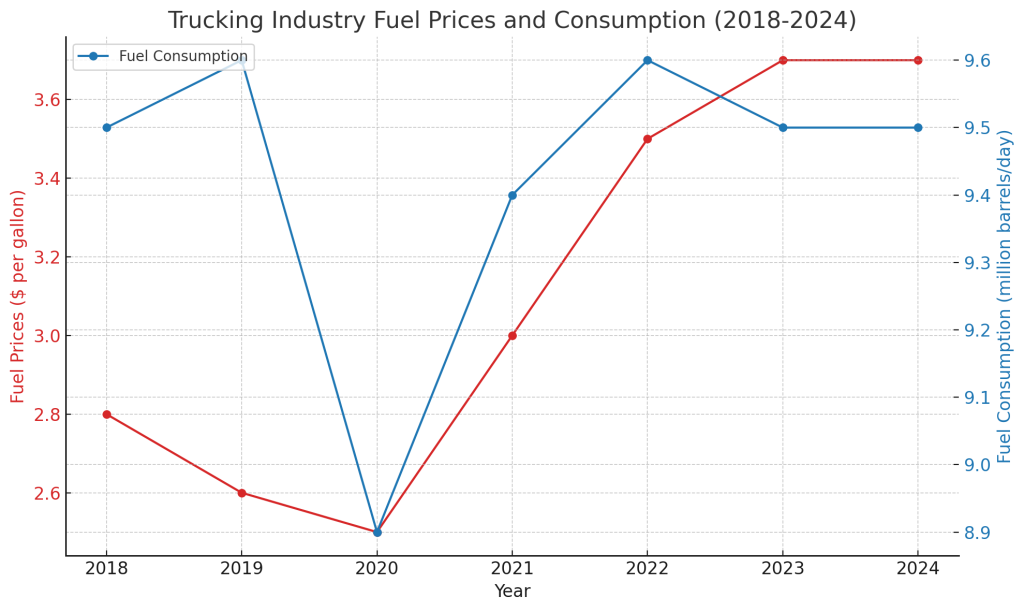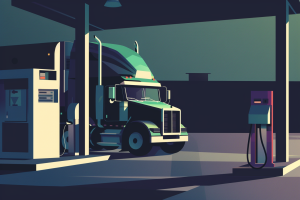- Discover why the trucking industry’s fuel demand remains stable despite soaring fuel prices, underscoring its essential role in freight transportation.
- Learn about the innovative strategies trucking companies are adopting to improve fuel efficiency and reduce operational costs.
- Explore the 2024 insights on technological advancements and regulatory changes shaping the future of the trucking industry.

The trucking industry fuel demand remains remarkably stable, even amid rising fuel prices.
The trucking industry fuel demand remains remarkably stable, even amid rising fuel prices. This indicates that the demand for fuel in this sector is inelastic, underscoring its essential role in freight transportation. For a comprehensive overview of the trucking industry.
Understanding the Inelastic Trucking Industry Fuel Demand
The Nature of Fuel Demand
In the trucking industry, the demand for fuel shows minimal sensitivity to price increases. This inelastic demand means that fuel consumption remains relatively constant, even when prices soar. This stability is critical for maintaining the efficiency of freight transportation and logistics operations. Learn more about fuel consumption trends in trucking.

The chart above illustrates the relationship between fuel prices and fuel consumption in the trucking industry from 2018 to 2024. Despite significant increases in fuel prices, fuel consumption has remained stable, highlighting the inelastic nature of fuel demand.
Key Observations:
- Fuel Prices: There has been a noticeable increase in fuel prices from 2018 ($2.80 per gallon) to 2024 ($3.70 per gallon).
- Fuel Consumption: Despite the increase in fuel prices, fuel consumption has remained relatively stable, around 9.50 million barrels per day.
Here is a detailed annual breakdown of fuel prices and consumption:
Enjoying our insights?
Subscribe to our newsletter to keep up with the latest industry trends and developments.
Stay Informed- 2018: Fuel Prices: $2.80 per gallon, Fuel Consumption: 9.50 million barrels/day
- 2019: Fuel Prices: $2.60 per gallon, Fuel Consumption: 9.60 million barrels/day
- 2020: Fuel Prices: $2.50 per gallon, Fuel Consumption: 8.90 million barrels/day
- 2021: Fuel Prices: $3.00 per gallon, Fuel Consumption: 9.40 million barrels/day
- 2022: Fuel Prices: $3.50 per gallon, Fuel Consumption: 9.60 million barrels/day
- 2023: Fuel Prices: $3.70 per gallon, Fuel Consumption: 9.50 million barrels/day
- 2024: Fuel Prices: $3.70 per gallon, Fuel Consumption: 9.50 million barrels/day
This data underscores the inelastic demand for fuel in the trucking industry, demonstrating that even significant price increases do not drastically alter fuel consumption
Why Fuel Prices Don’t Deter Demand
Economic Imperatives

This stability in fuel consumption underscores the essential role of fuel in freight transportation.
Fuel is a non-negotiable cost in the trucking industry, crucial for the movement of goods. Companies cannot significantly reduce fuel usage without compromising their operations. Consequently, even substantial price hikes do not drastically lower fuel demand. Explore strategies to manage fuel costs.
Operational Adjustments
To manage costs, trucking companies adopt various strategies such as improving fuel efficiency, optimizing routes, and reducing idle times. Technological advancements like adaptive cruise control and automated processes also contribute to cost management. Discover more about fuel efficiency technologies.
Impact of Rising Fuel Prices
Increased Operating Costs

Fuel is a non-negotiable cost in the trucking industry, crucial for the movement of goods.
The rise in fuel prices significantly impacts operating costs, driving up expenses for trucking companies. This scenario leads to higher freight rates, as companies adjust their pricing to offset fuel costs. Understand the impact of rising fuel prices on operational costs.
Shift in Market Dynamics
High fuel prices can shift market dynamics, affecting both spot and contract rates. While contract rates often include fuel surcharges, spot rates do not, making them more volatile and less predictable. Stay updated on market dynamics in the trucking sector.
Strategies for Fuel Efficiency
Trucking companies are investing in fuel-saving technologies and practices. From reducing speeds and limiting idle times to optimizing load management and route planning, these measures help in mitigating the impact of high fuel prices. Discover more about fuel efficiency technologies.
The Road Ahead for the Trucking Industry
Despite the challenges posed by high fuel prices, the trucking industry continues to adapt and evolve. With ongoing investments in technology and infrastructure, the sector aims to maintain its resilience and efficiency in the face of economic fluctuations.
2024 Insights on Fuel Demand in the Trucking Industry

Even substantial price hikes do not drastically lower fuel demand.
The trucking industry continues to exhibit inelastic fuel demand, maintaining stable fuel consumption even as prices fluctuate. Here are some updated insights and trends for 2024.
Market Dynamics and Fuel Costs
In 2024, the trucking industry is grappling with a mixed bag of challenges and opportunities. While fuel prices are expected to decrease slightly, the overall cost environment remains volatile due to geopolitical tensions and economic uncertainties. On-highway diesel prices are projected to average $3.70 per gallon, down from the previous year. Stay updated on market dynamics in the trucking sector.
Technological and Operational Adjustments
To counteract the high operational costs, trucking companies are investing heavily in fuel-saving technologies and operational efficiencies. The adoption of electric and alternative-fuel vehicles is gaining momentum, driven by both economic incentives and regulatory mandates, especially in states like California. Learn about the latest in logistics technology.
Industry Challenges
- Driver Shortage: The inelastic fuel demand in the trucking industry is exacerbated by a significant driver shortage, with the American Trucking Association warning of a potential shortage of 160,000 drivers by 2030. Efforts to address this include boosting recruitment, offering competitive wages, and improving working conditions.
- Insurance Costs: Rising insurance premiums, driven by higher litigation costs and accident rates, remain a concern. This is particularly challenging for smaller fleets, which are more financially vulnerable to such increases.
- Labor Regulations: New labor regulations, such as California’s Assembly Bill 5, are reshaping the classification of independent contractors, potentially increasing labor costs and operational complexity for trucking companies nationwide.
- Parking Issues: The lack of designated truck parking spaces remains a critical issue, affecting efficiency and safety for drivers across the country. This has been a persistent problem with limited response from local and federal authorities.
Emerging Trends
- Green Trucking: The push towards sustainability is stronger than ever, with increased adoption of electric trucks and alternative fuels. This shift not only aims to reduce emissions but also to lower fuel costs in the long term.
- Digital Transformation: The industry is rapidly digitizing with the use of blockchain, AI, and IoT. These technologies are revolutionizing logistics, improving efficiency, and reducing empty miles through better load matching and route planning.
Considering Market Conditions

Ongoing investments in technology and infrastructure help maintain resilience and efficiency.
The recent decline in gas prices across the U.S. offers additional context for the trucking industry. The national average for gas prices has dropped to around $3.44, down from $3.53 a week ago and significantly lower than last year (The Globe and Mail). This trend is driven by mild demand and strong supply, as well as relatively stable oil prices. Understanding these market conditions can help fleet managers plan their fuel purchases more effectively and take advantage of lower prices.
Core Findings and Future Outlook
The trucking industry’s fuel demand remains stable due to its inelastic nature, even in the face of rising costs. As the industry navigates through 2024, it is clear that technological advancements and sustainable practices will play pivotal roles in shaping its future. By adapting to new regulations and market conditions, trucking companies can maintain resilience and competitiveness in this dynamic landscape. By leveraging predictive maintenance, AI-driven route optimization, digital transformation, and advanced safety systems, fleet managers can improve operational efficiency and cost-effectiveness. Additionally, addressing driver training, retention, and parking issues will further enhance fleet management and ensure long-term success.
Key Insights & Developments in the Trucking Industry Fuel Demand
- Stable Fuel Demand: Despite rising fuel prices, the trucking industry’s fuel demand remains inelastic.
- Technological Advancements: Increased adoption of electric and alternative-fuel vehicles, along with AI and telematics, is enhancing fuel efficiency.
- Operational Strategies: Companies are optimizing routes, reducing idle times, and investing in digital transformation to manage costs.
- Industry Challenges: Ongoing issues include driver shortages, rising insurance premiums, labor regulations, and lack of truck parking.
- Sustainability Efforts: The push towards green trucking practices is stronger than ever, aiming to reduce emissions and operational costs.
Deep Dive into Trends and Technologies
Fuel Prices and Market Dynamics: According to Nova Lines, the trucking industry is expected to experience a mixed bag of challenges and opportunities in 2024. While fuel prices might slightly decrease, the overall cost environment remains volatile due to geopolitical tensions and economic uncertainties. Diesel prices are projected to average $3.70 per gallon in 2024, reflecting a slight decrease from previous highs (Nova Lines).

Technological advancements like adaptive cruise control and automated processes contribute to cost management.
Technological Adaptations: Trucking companies are increasingly investing in fuel-saving technologies and operational efficiencies. The adoption of electric and alternative-fuel vehicles is gaining momentum, driven by economic incentives and regulatory mandates, particularly in
states like California.
Sustainability Trends: The trucking industry is also pushing towards sustainability with the adoption of green trucking practices. This includes using alternative fuels, hybrid and electric trucks, and renewable energy sources to reduce emissions and fuel costs.
Extended Insights for Fleet Managers and Owner-Operators
For fleet managers and owner-operators, understanding and adapting to these trends can be crucial for maintaining competitiveness and efficiency in a fluctuating market. Here are additional insights and strategies that can be beneficial:
Investing in Predictive Maintenance: Predictive maintenance is becoming increasingly important in the trucking industry. This approach utilizes telematics and advanced data analytics to monitor vehicle performance and predict potential failures before they occur. By integrating predictive maintenance systems, fleet managers can significantly reduce unplanned downtime, optimize maintenance schedules, and extend the lifespan of their vehicles. This not only helps in managing operational costs but also improves overall fleet reliability and efficiency.
Optimizing Route Planning with AI: Advanced route planning systems using artificial intelligence (AI) and machine learning algorithms can help fleet managers optimize delivery routes. These systems analyze traffic patterns, weather conditions, and delivery schedules to recommend the most efficient routes. This not only reduces fuel consumption and travel time but also enhances customer satisfaction by ensuring timely deliveries. Implementing AI-driven route optimization can lead to substantial savings in fuel costs and operational efficiencies.
Embracing Digital Transformation: The digital transformation of the trucking industry involves adopting technologies such as blockchain, Internet of Things (IoT), and advanced telematics. Blockchain can enhance transparency and security in supply chain transactions, while IoT devices provide real-time data on vehicle performance, cargo conditions, and route status. Leveraging these technologies enables fleet managers to make data-driven decisions, improve asset utilization, and streamline operations. Enhanced digital infrastructure can also facilitate better compliance with regulatory requirements and improve overall operational efficiency.
Enhancing Driver Training and Retention: Addressing the driver shortage remains a critical challenge. Investing in comprehensive driver training programs can help improve driver skills and safety, reducing the likelihood of accidents and improving overall fleet performance. Additionally, implementing retention strategies such as competitive compensation, health benefits, and creating a positive work environment can help retain experienced drivers and attract new talent. This is crucial for maintaining a stable and efficient workforce in the face of increasing demand and regulatory changes.
Utilizing Fuel Management Systems: Fuel management systems are essential tools for fleet managers to monitor and control fuel usage. These systems provide insights into fuel consumption patterns, identify potential areas of waste, and offer recommendations for improving fuel efficiency. By implementing fuel management systems, fleet managers can better manage fuel costs, reduce emissions, and improve overall operational efficiency. Such systems can be integrated with other fleet management tools to provide a comprehensive view of fleet performance.

The trucking industry continues to exhibit inelastic fuel demand, maintaining stable consumption even as prices fluctuate.
Addressing Parking Issues: The lack of designated truck parking spaces remains a critical issue, affecting efficiency and safety for drivers across the country. This has been a persistent problem with limited response from local and federal authorities. When drivers are unable to find adequate parking, they may spend extra time idling or driving around, which increases fuel consumption and impacts operational efficiency. Finding solutions to this issue can help reduce unnecessary fuel usage and improve overall operational effectiveness.
By staying informed about these trends and adopting innovative strategies, fleet managers and owner-operators can navigate the complexities of the trucking industry and maintain a competitive edge. These insights and strategies not only address current challenges but also position fleets for long-term success in a rapidly evolving market.
Enhancing Fleet Management with Technology
Leveraging Telematics for Efficiency: Telematics systems offer real-time insights into vehicle location, speed, and driver behavior, enabling fleet managers to monitor and optimize their operations. By analyzing telematics data, fleet managers can identify patterns and areas for improvement, such as reducing idle times, improving route efficiency, and enhancing driver performance. This technology can lead to significant cost savings and improved operational efficiency.
Implementing Advanced Safety Systems: Advanced safety systems, including collision avoidance technology, lane departure warnings, and adaptive cruise control, are becoming standard in modern trucks. These systems enhance driver safety, reduce the risk of accidents, and can lead to lower insurance premiums. Investing in these technologies not only improves the safety of fleet operations but also contributes to overall cost savings by minimizing accident-related expenses.
Utilizing Data Analytics for Decision Making: Data analytics tools allow fleet managers to make informed decisions based on comprehensive data from various sources. By integrating data from telematics, fuel management systems, and maintenance records, managers can gain a holistic view of fleet performance. This approach facilitates proactive decision-making, helping to address issues before they become major problems and optimizing overall fleet efficiency.
Historical Insights into Inelastic Trucking Industry Fuel Demand
The inelastic nature of fuel demand in the trucking industry has deep historical roots. The concept of inelastic demand, where the quantity of fuel consumed remains relatively stable despite fluctuations in price, can be traced back to the industry’s reliance on diesel as a primary fuel source since the early 20th century. Diesel engines, introduced in the 1920s, offered greater fuel efficiency and power compared to gasoline engines, quickly becoming the standard for heavy-duty trucks.
During the oil crises of the 1970s, the trucking industry demonstrated remarkable resilience. Despite significant spikes in fuel prices, the demand for diesel remained steady. This period underscored the essential role of fuel in freight transportation and highlighted the industry’s limited ability to reduce fuel consumption without compromising operations.
In recent decades, advancements in fuel efficiency and technology have continued to shape the industry’s fuel demand. The adoption of fuel-efficient engines, aerodynamic designs, and advanced logistics planning have helped mitigate the impact of rising fuel costs. However, the fundamental inelasticity remains, driven by the critical need to maintain consistent delivery schedules and meet the demands of a growing economy.
The stability of fuel demand is also influenced by regulatory changes and environmental standards. For instance, the introduction of the Clean Air Act amendments in the 1990s and subsequent regulations have pushed the industry towards cleaner technologies and fuels, yet the overall fuel consumption patterns have remained relatively unchanged. This historical context underscores the unique position of the trucking industry, where fuel demand remains a non-negotiable aspect of operations, reflecting its indispensable role in modern commerce and logistics.
Discover More About Inelastic Trucking Industry Fuel Demand
Explore detailed insights and authoritative sources on the inelastic fuel demand in the trucking industry through these valuable external resources:
- Impact of Fuel Costs: The American Transportation Research Institute (ATRI) provides insights into the ongoing impact of fuel costs in the trucking industry. Learn more at ATRI.
- Rising Fuel Costs: Discover the widespread impacts of rising fuel costs and their implications on the industry at DAT.
- Market Shifts: Explore how high fuel prices and market shifts are affecting the trucking industry at HD Trucking.
- Operational Strategies: Find strategies to manage higher operational costs due to fuel prices at TheTrucker.com.
- 2024 Trends: Stay updated on trucking industry trends and predictions for 2024 at Nova Lines.
- Innovative Approaches: Learn about innovative approaches in trucking, including digital transformations and sustainability efforts, at CloudTrucks.
- Technological Advancements: Dive into technological advancements in the trucking industry, such as AI, telematics, and IoT, at TruckLabs.
- Industry Report: Read the state of the industry report for 2024, providing an in-depth overview of trends and challenges at FreightWaves.





















